Table of Contents[Hide][Show]
A nourishing homemade baby formula using safe, whole ingredients. This recipe was developed and tested by Dr. Mary Enig, a PhD Nutritionist and originally published in Nourishing Traditions cookbook in 1996. It was formulated to match breastmilk as closely as possible and is also suitable for infants. Source: Weston A. Price Foundation
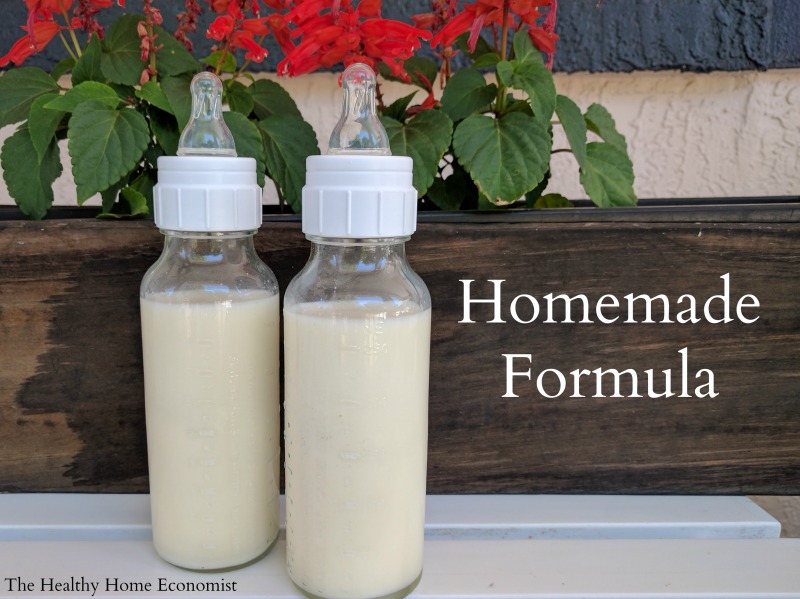
There is no doubt that breastfeeding your baby is the best option for the child’s long-term health and development. Human breastmilk from a well-nourished mother is the perfect food for baby. However, in circumstances where the child is adopted or the Mother finds herself unable to breastfeed, formula feeding becomes necessary. In those cases, homemade baby formula is best.
Using a baby formula recipe that closely matches the nutritional profile of breastmilk is a far better choice than even organic baby formula from the health food store. More on this below.
Note: Donor programs are widely available for human breastmilk. But, the diets of the donor mothers are unknown and most likely nutritionally insufficient. In addition, breastmilk banks pasteurize the donated breastmilk which destroys much of the nutritional benefit. Unless you are fortunate to have a trusted and direct donor milk source in your community, avoid this option!
Dangers of Commercial Formula
Commercial formulas are always a poor choice for a number of reasons. First of all, formula manufacturers line the cans with the chemical BPA. This substance disrupts hormone development and is a probable contributor to early puberty in girls, and ADHD, urogenital abnormalities, and other ills in boys.
The European Food Safety Authority found that canned commercial formula is a significant source of BPA for infants, exposing the child to 13mcg of BPA per kg of body weight per day! BPA-free formula cans are no better. The chemical BPS is typically used instead which is just as dangerous.
Beware that manufacturers pack even organic commercial formula like Earth’s Best in BPA cans. Worse, they use organic brown rice syrup as the primary sweetener which is known to be frequently contaminated with arsenic.
In addition, all commercial milk formulas are processed at extremely high temperatures which violently denature the fragile milk proteins, render them allergenic, and add carcinogens to the final product. Soy infant formula is the worst. Obscenely high processing temperatures not only denature the proteins but large levels of phytic acid in soy block mineral absorption by the infant. Moreover, soy-based plant estrogens disrupt the hormonal development of the baby!
It seems that for the concerned Mother who is unable to breastfeed, learning how to make baby formula at home with safe, pure ingredients is the most prudent way to go!
Why Make Homemade Formula Even if You Are Breastfeeding
In the video below, I show you how to make your own safe, healthy raw milk homemade formula for your baby.
The recipe I follow was originally published in the cookbook Nourishing Traditions in 1996 and developed by Dr. Mary Enig.
Even though I breastfed each of my children for at least 2 years, I made this exact formula for my own children when I was away for the day or the evening as pumping was not an option that worked well for me.
I even used this homemade formula for an entire day once when I had some dental work done and was advised to pump and discard for 24 hours.
As a result, even successfully breastfeeding Moms can use this wonderful homemade formula as a supplement when necessary to their own nutrient-dense breastmilk!
It is advised that even breastfeeding Mothers have the ingredients for this formula on hand for an emergency. If Mom is sick or otherwise unable to nurse, Dad can step in and make this safe alternative until Mom is back on her feet. It takes a few days to a week to gather all the ingredients together to make this formula, which is why I advise having them on hand at all times.
Homemade Most Nutritious
The image below lists the reasons why it is worth it nutritionally to make formula yourself for your precious baby!
You can order all of the required ingredients for the homemade baby formula in one package from this reputable, vetted source.
Moms who have successfully used this formula feeding your children, please post about your experience in the comments section to encourage those who are considering it and need some Mom to Mom encouragement!
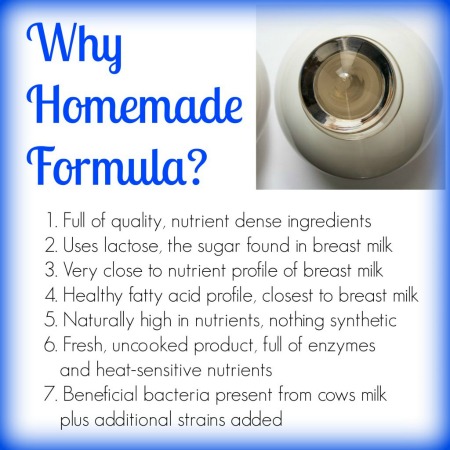
Where to Source Quality Milk
The most widely available grass-fed milk around the world is from cows. This is usually the most budget-friendly and easily sourced milk for this recipe for homemade formula.
If only goat milk is available in your area, this recipe for goat milk baby formula can be used instead. When using milk from ewes, please refer to the linked article for an adjusted recipe; one of the benefits of sheep milk is that it is higher in healthy fats than either goat or cow milk.
Camel milk formula is another option that is a particularly digestible form of dairy and growing in popularity around the world.
Alternatively, you can use low temp (vat) pasteurized, non-homogenized whole milk cultured with a piima or kefir starter. Then substitute the piima milk or kefir for the raw milk portion of the formula recipe. Cold-pressed raw milk also must be cultured before using it as it contains no probiotics.
Do NOT use ultrapasteurized (UHT) milk even if organic as it is too highly processed and extremely allergenic!
It is also best to avoid all types of powdered milk for this recipe. The factory process of making milk powder reduces nutrition considerably and denatures it, which makes it more likely baby will have an allergic reaction.
Dairy Allergy Option
If all types of dairy prove unsuitable for your baby, make this nondairy baby formula recipe instead. It uses a base of homemade bone broth as a substitute for milk. It is important not to utilize a plant-based or otherwise vegan baby formula recipe.
Avoid buying bone broth to make the dairy-free formula. Make it yourself! Manufacturers of commercial bone broth, even if authentic, may water down the end product. This is apparent if it does not gel when chilled in the refrigerator.
Many brands have toxic packaging issues as well. If you must buy it in a pinch, see my shopping guide page for vetted brands that are safe.
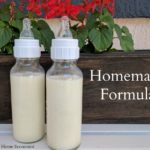
Homemade Baby Formula Recipe (for infants too)
A nourishing baby formula recipe you can make at home with safe, whole ingredients developed and tested by a PhD nutritionist to match breastmilk as closely as possible. Also suitable for infants.
Ingredients
- 2 cups raw cow milk OR organic whole milk yogurt
- 1 7/8 cups filtered water
- 1/4 cup liquid whey
- 4 Tbl lactose
- 1/4 tsp Bifidobacterium infantis powder
- 2-4 Tbl raw or pasteurized cream
- 1/2 tsp cod liver oil unflavored
- 1/4 tsp butter oil unflavored
- 1 tsp sunflower oil preferably organic
- 1 tsp extra virgin olive oil preferably organic
- 2 tsp virgin coconut oil preferably organic
- 2 tsp nutritional yeast
- 2 tsp gelatin
- 1/4 tsp acerola powder
Instructions
-
Fill a 2 cup Pyrex measuring cup with filtered water and remove 2 TBL (this will give you 1 7/8 cup water).
-
Pour about half the water into a pan and turn burner on medium.
-
Add the gelatin and lactose and let dissolve, stirring occasionally.
-
When gelatin and lactose are dissolved, remove pan from heat and add the rest of the water to cool.
-
Stir in the coconut oil and butter oil until melted.
-
Put remaining ingredients in a glass blender.
-
Add the water mixture and blend for about 3 seconds.
-
Place formula in glass baby bottles or a glass jar and refrigerate.
-
Before giving to baby, warm glass bottle in a pan of hot water or a bottle warmer. NEVER microwave baby bottles!
Recipe Video
Recipe Notes
If using raw cow milk from holstein cows, use 4 Tbl of extra cream (otherwise use 2 Tbl extra cream).
If choosing to make this homemade formula with camel milk, be sure to include 4 Tbl extra cream as camel milk is lower in cream than cow milk.
Do not use high oleic sunflower oil. Use only the brand recommended in the ingredients list which is cold pressed, organic, unrefined, and low oleic.
*Do NOT use powdered whey from the store as it is denatured. Avoid whey from making cheese as it will curdle the formula.
*Do not substitute pasteurized or powdered milk as these are heavily processed, denatured and allergenic foods.
*Do NOT use ultrapasteurized (UHT) cream. It is highly allergenic. Raw or pasteurized cream is acceptable.
*Do NOT use fish oil or krill oil instead of high vitamin cod liver oil as they do not contain any Vitamin D and very little to no Vitamin A.
Collagen powder may be substituted for the gelatin in a pinch (more on peptides in baby formula in this article).
If you are wondering where is the iron in homemade baby formula, this article provides an explanation.
If baby experiences constipation using this formula, try adding 1 tsp of molasses to each batch. This should help move things along.
How to Transition to DIY Formula
Once you’ve viewed the video, gathered the ingredients, and made your first batch, how do you feed it to your baby for the first time?
It is important not to switch all at once as this can cause gas, excessive spit-up, or an uncomfortable change in diaper habits such as constipation or overly loose stools.
Start by giving your baby three-quarters of the old formula blended with one-quarter of the homemade. Try this ratio for a day or two and see how your infant responds.
If no digestive upset or major change in diaper habits occurs, increase the amount to a 50-50 blend of old formula to homemade. Observe for another day or two as before.
If no major issues, increase once again to three-quarters homemade formula to one-quarter old formula. If baby does well on this blend for a third time, you are ready to fully transition to the homemade formula.
At any time during the transition, symptoms of intolerance emerge, back up to the previous successful blend ratio and stay there for a day or two before attempting to increase once again.
Homemade Formula FAQ
Weston Price Foundation
Feeding an Adopted Baby
Traveling Tips with Baby Formula Made at Home
Iron in Baby Formula
Collagen Peptides instead of Gelatin for Homemade Formula?


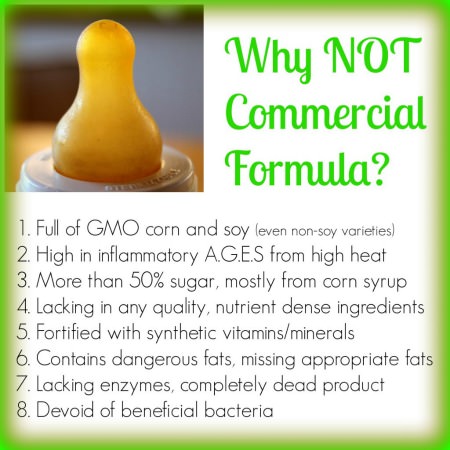
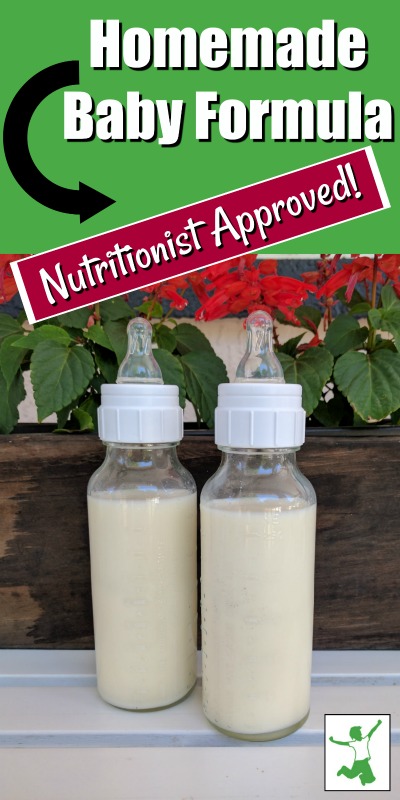






I know this may have been asked before, and if it has, I’m sorry…could you please direct me to the comment?
Why is it that we’re told that our babies cannot have milk before their first birthday and ESPECIALLY before they’re 6 months old when the #1 ingredient in milk-based formula is NON-FAT MILK? How in the world is this any different from giving them fortified milk, which this formula basically is?!?! I don’t understand other than the fact that “big formula” stands to benefit greatly off of this advice.
Hi Janelle, whole raw milk is the primary ingredient in this formula, not non fat milk.
The whole milk has additional ingredients added to improve digestibility for the baby’s immature digestion such as gelatin, additional probiotic, lactose (of which human breastmilk is much higher in than cowmilk) – even additional cream is added for improved digestibility. Not giving plain whole raw milk before the first birthday is suggested as it would not provide the nutrition necessary for a baby who is not eating enough solid foods as well which is why the many other ingredients are added as well for the formula to mimic human breastmilk as closely as possible.
I’m sorry, I should have been more specific. I meant milk-based COMMERCIAL formula.
How long can this formula be refrigerated for? Another question, which may appear ridiculous but, if baby doesnt drink all of the formula at one sitting is there any longevity to how long it can be out for before it is bad? An hour at most? I wasnt sure and have not taken any chances but was just wondering.
Thank you
April
Hi April, the formula is fine for about a week in the fridge and a couple of hours on the counter does no harm. Remember, raw milk does not go “bad” like pasteurized milk. It clabbers which means the probiotics increase in number and consume the lactose which naturally sours the milk into clabbered milk. But, clabbering is a process that takes a day or two out of the refrigerator.
One more question, does the CLO have to be FERMENTED?
Okay, 2 more questions: I’m trying to make this as cost effective as possible, while also making it as nutrient rich as possible…could you give me the reasons WHY I would want to include the butter oil? I mean, it sounds fantastic…but will my son benefit GREATLY from it, or is it just another wonderful addition?
the weston a price founddation website basically says to double the amount if it is not fermented. you should go there for your questions. also it says the butter oil is optional. it adds vitamins, including vitamin k which is supposed to be an activator for other vitamins.
Can you use the cod liver oil/butter oil combination? Also, is there another probiotic that can be used? I’ve seen specially formulated probiotics for infants that CONTAIN the probiotic listed, but they also contain others, would this be okay?
Hi Janelle, only use bifidobacterium infantis NOT another brand with other strains. Do not use the FCLO/BO combo as it is in a ratio of 3:1 which is not correct for making the baby formula (the ratio for the baby formula as seen in the ingredients list is 2:1)
Thank you! 🙂 I’m headed to Whole Foods to see if I can find any of this without paying the shipping!
Sarah,
I’m so excited to find out about this formula! Do you know what the iron content of this formula is like? I’ve suffered with anemia all my life, so I want to make sure my little girl has a good source of iron if I blend up this mixture for her.
Thanks so much 🙂
Do you happen to have any idea how much formula all of these ingredients will make (other than the milk, of course)?? I’d love to make this, but I’d like to get a feel of how much it might cost per ounce once I’ve bought everything up front.
The whole breast is best argument is all fine and dandy, but there truly ARE some of us out here who have bona fide supply issues. I’m currently pregnant with #5 and got pregnant when #4 was 3 months old. My supply naturally drops at 3-4 months as apparently I’m made for MAKING babies, not FEEDING babies. With my first, I was bound and determined to breastfeed for a year. She was little, she was irritable and my life was miserable. Once she started on milk at a year old, she got WAY bigger, started sleeping well and was generally happy. I’ve done formula with all the rest of my babies since around 5-6 months. My current little guy was on Nutramigen…not only is it ridiculously expensive, it cannot possibly be healthy with the broken down proteins. Everything I read said that I really had no other options when he was so young (4 months)…we’re currently using Enfamil and I’m not THRILLED with using it by any means, but until I saw this, I really had no other option. I fully agree that breast is best…I’m a HUGE advocate of breastfeeding, but for some of us it’s just not possible!
i just did all the calculations for myself. as of jan 2013, pricing the ingredients on vitacost and amazon, and local prices for milk, cream, and yogurt (to make whey), I found the cost per 36 ounce batch to be $3.25. I can buy a 40 ounce can of commercial formula, which makes 40 ounces, for $22.00. So there is an upfront cost to gather the ingredients. But buy in bulk and you will save a lot of money in the long run.
Hi Sarah, please help – I am missing one of the ingredients that I somehow missed of the list – LACTOSE. Can I purchase it from a local Whoie Foods market ? If so , are there any preferable brands or stuff/formulations to avoid ?
THANK YOU AGAIN… I AM ALMOST THERE 🙂
Hi Sarah, what is the best recommendations for yogurt brands to be used for homemade whey ?
I buy raw yogurt from a small local farm, but if you must buy pasteurized yogurt at the store, Seven Stars plain whole yogurt is definitely the best brand.
Hi Sarah,
I am not sure if my whey came out right. I used cheese towel over a strainer and left the yogurt there for about 12 hours. What leaked in the bowl is not a clear yellowish liquid but it does have some white color to it as well as is some yogurt curd also leaked into it. is this OK ? or should I remake it ? Where can I get tea towels ? and how many hours exactly should I keep the yogurt out of the fridge ?
THANKS IN ADVANCE!
Hi Regina, making whey and yogurt cheese on the counter is not an exact science. 12 hours should be about right though. A bit of white curd in there is fine as well as a bit of white streaks amidst the yellow whey. Perfection is totally not necessary to achieve fantastic results! 🙂
I have a question on home-made whey: How many hours exactly would it have to stay at room temperature( I am using whole milk yogurt) before refrigeration?